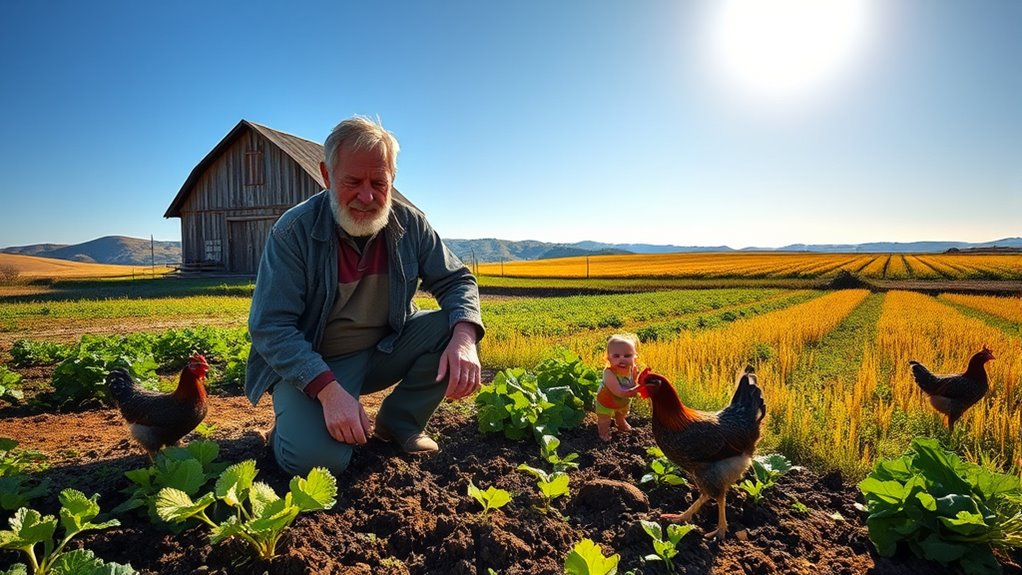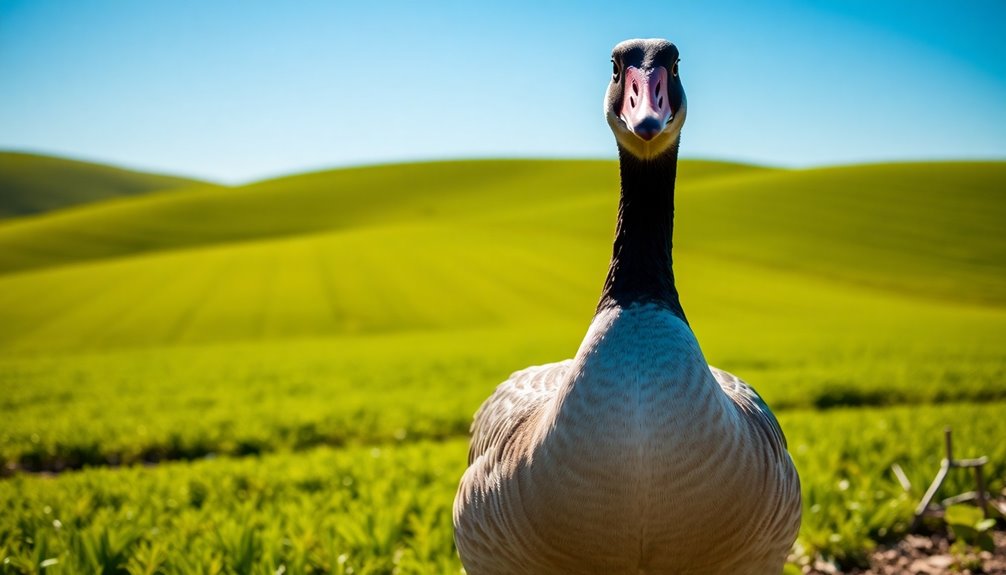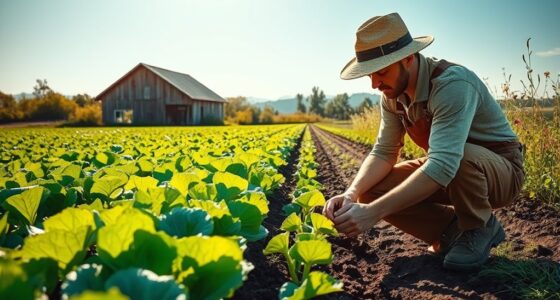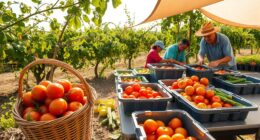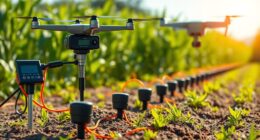Subsistence farming is all about growing food mainly for your own family's consumption, not for sale. You typically use traditional tools and methods on small plots of land, focusing on self-sufficiency. This type of farming can be seen in developing countries where resources are limited. You might encounter practices like mixed cropping or nomadic herding. If you're curious about its impact, types, and the challenges faced by farmers, there's much more to explore.
Key Takeaways
- Subsistence farming is a method of agriculture focused on producing food primarily for personal consumption rather than for sale.
- It typically involves small-scale farming, utilizing manual labor, traditional tools, and mixed cropping techniques.
- Types of subsistence farming include shifting agriculture, nomadic herding, and intensive subsistence farming, each adapted to local environments.
- This farming practice promotes food security, community ties, and cultural traditions, especially in rural areas of developing countries.
- While it has environmental benefits, such as soil conservation and biodiversity, subsistence farming faces challenges like climate change and soil degradation.
Definition of Subsistence Farming

Subsistence farming, at its core, focuses on producing food primarily for personal consumption rather than for sale.
You'll find this practice often involves small-scale farming on limited land, relying heavily on manual labor and traditional tools. The main goal is to ensure food security for your family or small community, resulting in little to no surplus for market sale.
This method is common in developing countries where modern agricultural inputs are scarce. Characterized by minimal capital and external resources, subsistence farming emphasizes mixed cropping and natural fertilizers.
You'll notice that traditional farming methods dominate, with family members typically providing the labor. By relying on local resources and knowledge, subsistence farming helps maintain cultural practices and community ties.
Types of Subsistence Farming
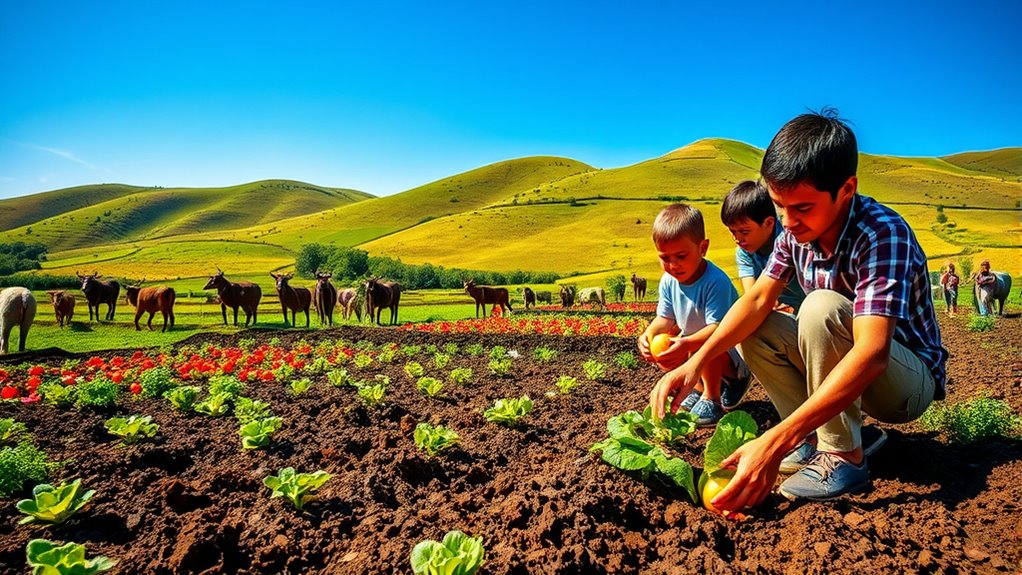
While various methods exist to sustain livelihoods, types of subsistence farming can be categorized based on their specific practices and regional adaptations.
Shifting agriculture involves clearing land and moving after depleting soil nutrients.
Primitive farming utilizes basic technology on small plots near homes, often relying on household fertilizers.
Nomadic herding focuses on raising livestock while moving to various grazing areas.
Intensive subsistence farming emphasizes high labor input to produce multiple crops on small plots.
Lastly, terrace farming creates flat areas on hillsides to optimize land use.
Each type reflects cultural and environmental factors, shaping how communities meet their food needs sustainably.
Understanding these types helps appreciate the diverse approaches to subsistence farming worldwide.
Characteristics of Subsistence Farming
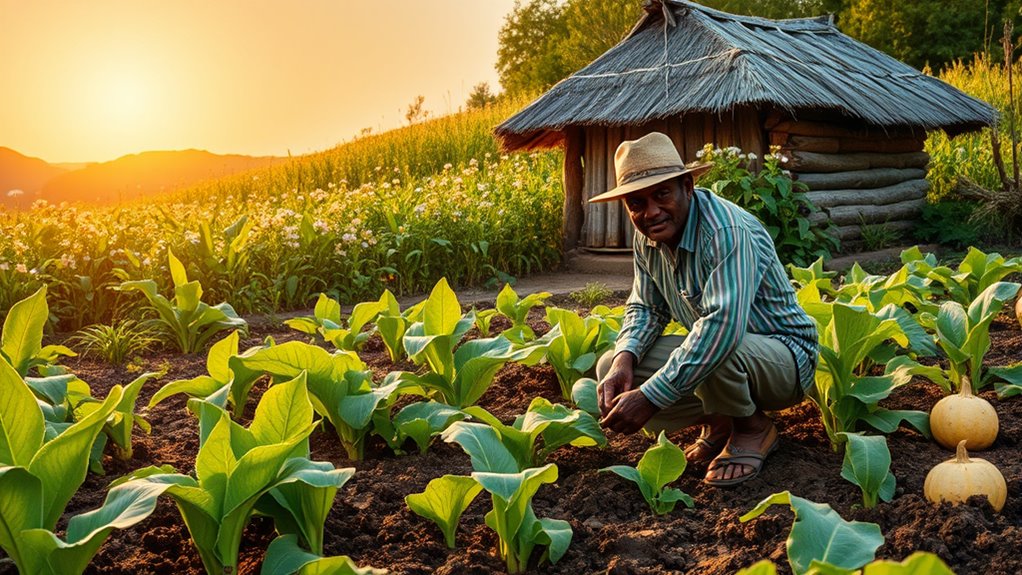
Understanding the various types of subsistence farming sets the stage for exploring its defining characteristics.
You'll notice that subsistence farming typically requires small capital investment, focusing mainly on family consumption rather than market sales. Farmers often trade goods through a barter economy and rely on unimproved crop varieties, resulting in low yields.
Agricultural practices include mixed cropping, using traditional tools, and minimal agrochemicals, while natural fertilizers like manure enrich the soil.
Socially, family labor dominates, emphasizing self-sufficiency and cultural significance. Commonly found in rural areas of developing countries, subsistence farming reflects local adaptations to various environments.
It plays a crucial role in ensuring food security while preserving traditional lifestyles.
Environmental Impact of Subsistence Farming

The environmental impact of subsistence farming is significant, as it intertwines traditional agricultural practices with local ecosystems.
You'll find that these methods often promote soil conservation, maintaining fertility and preventing erosion. Unlike commercial farming, subsistence farming typically uses less water, relying on natural rainfall and small-scale irrigation.
It supports biodiversity by maintaining diverse crop varieties and practicing natural pest management. With minimal use of synthetic fertilizers and pesticides, it reduces chemical pollution.
However, challenges like climate change vulnerability and soil degradation can arise. Sustainable practices such as crop rotation and intercropping enhance soil health and biodiversity.
Ultimately, subsistence farming fosters community resilience and protects local ecosystems, contributing positively to environmental sustainability.
Economic Role of Subsistence Farming
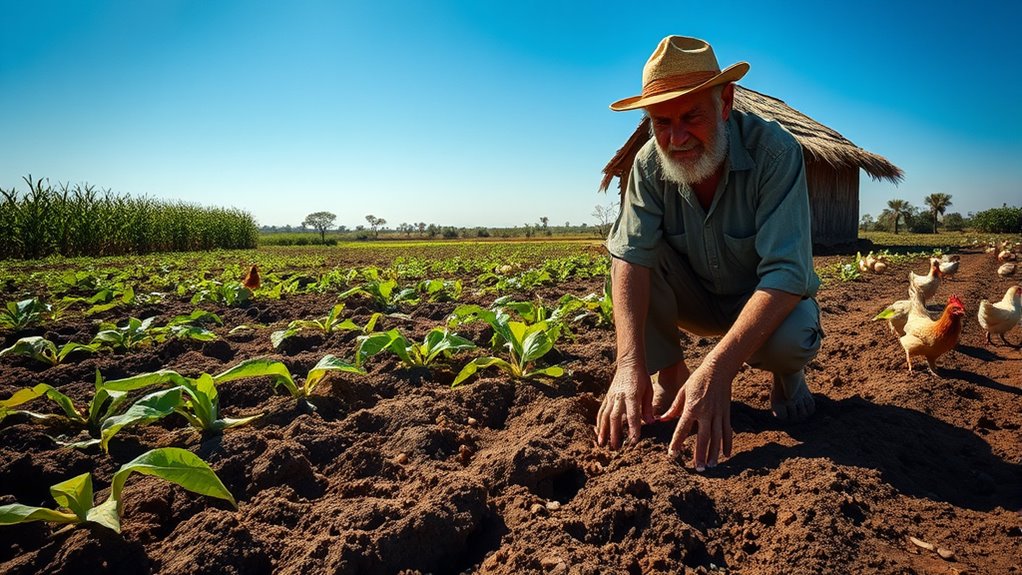
Subsistence farming plays a crucial economic role in many communities, especially where access to markets and resources is limited.
You'll find that families often practice this type of farming out of economic necessity, producing food without relying heavily on outside inputs. With minimal financial investment, it becomes accessible to resource-poor communities.
This approach not only provides a safety net during economic downturns but also helps reduce poverty among those with very low incomes. While the focus is on self-sufficiency, some farmers engage in limited trade through bartering.
Ultimately, subsistence farming promotes economic sustainability, supports local economies, and fosters community ties, ensuring food security and stability for those involved.
Global Presence of Subsistence Farming
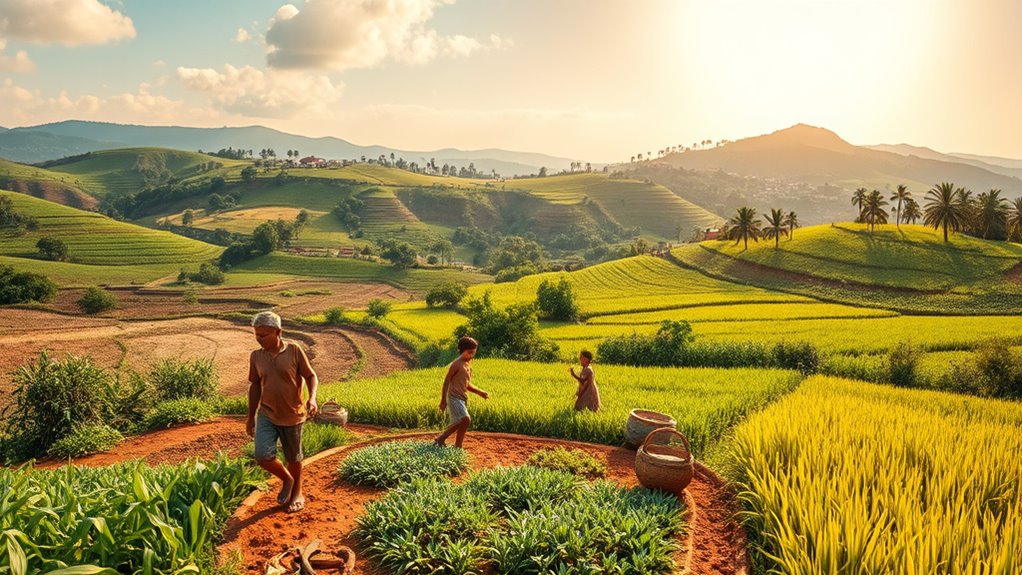
While many people mightn't realize it, subsistence farming is a lifeline for billions around the globe, particularly in rural regions of Africa, Asia, and Latin America. About 2 billion people rely on this practice for survival, with 80% of farmers in India and nearly all farmers in China working on small farms.
In sub-Saharan Africa, subsistence farming plays a vital role in local economies, often involving traditional methods and tools. You'll find that many smallholder farmers produce about one-third of the world's food, despite facing poverty and challenges from climate change.
Urbanization threatens this practice, but subsistence farming still provides essential food security and income for countless families worldwide.
Examples of Subsistence Farming Practices
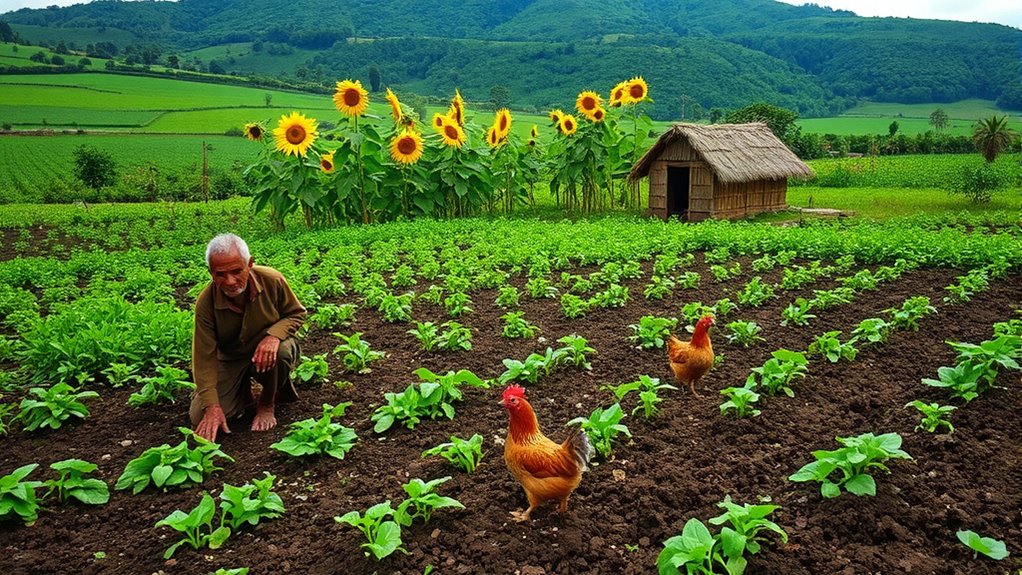
Recognizing the significance of subsistence farming across the globe leads us to explore the various practices that sustain millions of families.
One common method is shifting cultivation, where you clear land by burning vegetation and move to new areas when soil fertility declines.
Intensive subsistence farming makes the most of small plots through manual labor and multiple cropping.
In arid regions, pastoralism focuses on livestock rearing, while mixed farming combines crops and livestock for diversified production.
Terrace farming helps prevent erosion by creating flat areas on hillsides.
Techniques like crop rotation, intercropping, and using natural fertilizers enhance soil health, ensuring that these vital practices continue to provide food and livelihoods for countless communities.
Challenges Faced by Subsistence Farmers
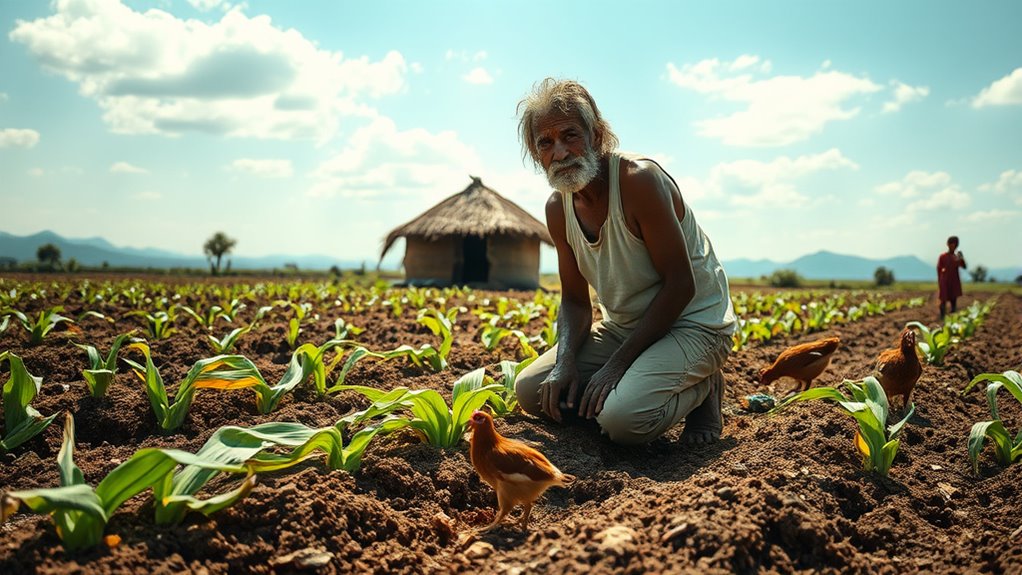
Despite the vital role subsistence farmers play in global food production, they face a myriad of challenges that threaten their livelihoods.
Limited access to modern technologies and financial resources restricts your ability to invest in essential farming inputs like fertilizers and seeds. Inadequate infrastructure complicates market access, while climate change poses risks like droughts and floods that jeopardize food security.
Low productivity traps you in cycles of poverty, and high input costs eat into your profits. Socially, gender disparities and limited education hinder progress, and health risks rise due to inadequate healthcare.
Without government support and investment in rural infrastructure, overcoming these challenges becomes even more daunting, leaving you vulnerable in a rapidly changing environment.
Frequently Asked Questions
How Does Subsistence Farming Differ From Commercial Farming?
Subsistence farming differs from commercial farming in several key ways.
You focus on meeting your household's immediate needs, while commercial farmers aim for profit and market demands.
Your operations are usually small-scale, relying on traditional methods and minimal technology, whereas commercial farms are larger and more mechanized.
You prioritize diverse crops for personal consumption, while commercial farming specializes in specific crops for sale, often using chemical inputs to maximize yields.
What Skills Are Essential for Successful Subsistence Farming?
To thrive in the garden of subsistence farming, you need a well-rounded skill set.
Think of it as crafting a symphony; you'll harmonize crop selection, soil management, and pest control. You must cultivate knowledge of local climate and resources while nurturing community connections.
Adaptability is your conductor, guiding you through challenges. With patience and a willingness to learn, you'll reap the fruits of your labor and sustain your family's needs.
Can Subsistence Farming Be Sustainable Long-Term?
Yes, subsistence farming can be sustainable long-term, especially when you implement traditional methods that promote soil health and biodiversity.
By using compost, practicing crop rotation, and relying on local resources, you can reduce environmental impact.
However, you'll need to adapt to challenges like climate change and limited technology.
Emphasizing community involvement and maintaining cultural practices can also strengthen the sustainability of your farming efforts, ensuring food security for future generations.
What Crops Are Commonly Grown in Subsistence Farming?
In subsistence farming, you'll commonly grow a variety of crops tailored to your region and needs.
Grains like rice, maize, and wheat are staples, along with root crops such as potatoes and sweet potatoes for added nutrition.
Legumes like beans and lentils provide protein, while various vegetables and fruits enhance your diet.
You might also cultivate tubers like cassava and yams, ensuring a diverse and nourishing food supply for your family.
How Do Climate Changes Affect Subsistence Farmers?
Climate change hits subsistence farmers like a sudden storm, disrupting their livelihoods and crops.
You'll notice that rising temperatures and erratic rainfall make planting and harvesting unpredictable. Extreme weather events can devastate yields, leaving you with less food and income.
As resources dwindle, your health and well-being might suffer too, compounding stress and limiting access to essential services.
Adapting becomes increasingly challenging, as financial and informational barriers stand in your way.
Conclusion
In conclusion, subsistence farming plays a vital role in sustaining communities worldwide. Imagine a small village in India where families grow rice and vegetables just for their own needs. They rely on traditional methods, passing down knowledge through generations. While this practice supports local diets, it faces challenges like climate change and market pressures. By understanding and supporting subsistence farmers, we can help preserve their way of life while promoting sustainable agriculture for the future.

